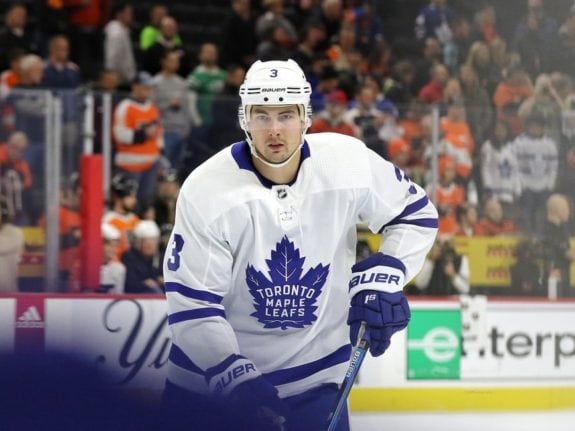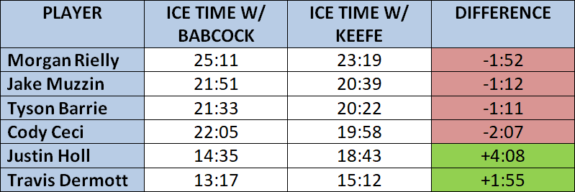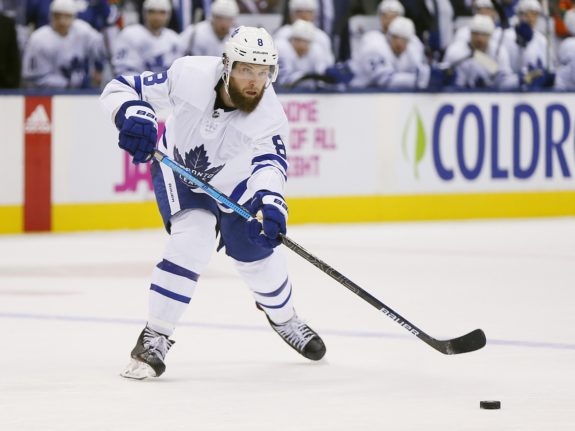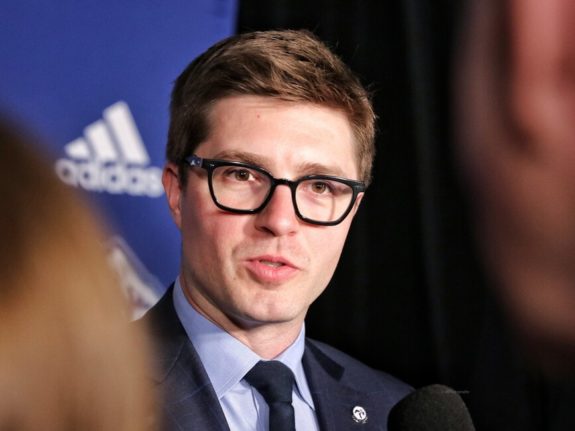The Toronto Maple Leafs closed out 2019 with what could be called a quiet move, extending 27-year-old defenceman Justin Holl to a three-year deal that will pay him $2 million per season. But despite the relatively small payout, the move said volumes about the Maple Leafs, their front office, and their future.

So why exactly did general manager Kyle Dubas decide to make a bet on Holl, and will the right-handed defenceman live up to his new deal?
Can Holl Live Up to the Contract?
First things first: is Holl worth the money?
Make no mistake, $2 million is a lot of dough for anyone. In the NHL, however, that salary will put you towards the lower end of the pay scale. When we compare Holl to his peers around the league, you really get a picture of how much he’s making in the grand scheme of things. His cap hit for 2020-21 would rank him 131st in the league among defencemen this season, tied with not-so-household names like Ryan Pulock and Jordie Benn.
Now for some quick math: there are 31 teams in the league, and each team has six defencemen. In a perfect world, the 31 highest-paid players would be your No. 1 defencemen, 32-62 would be your No. 2s, and so on. This means that Holl, with the 131st-highest cap hit among defencemen, is being paid like a high-end No. 5.
Off the top of my head, that sounds like a good deal for the Maple Leafs, especially when you consider Holl’s usage. The 6-foot-4 defender is averaging 16:29 of ice time per game this season, good for fifth among Maple Leafs defencemen. But since Sheldon Keefe was named head coach in late November, Holl’s game has really taken off as he’s seen significantly more ice time and an increased role.

While Holl is still being deployed fifth-most under Keefe, he has had the largest uptick in usage under the Maple Leafs’ new bench boss with an increase of over four minutes per game. He’s also being used in a shutdown role alongside Jake Muzzin as the two have generally been tasked with matching up against top competition.
Since that pairing has been put together, they’ve had sterling results: in 16 games under Keefe, the Holl-Muzzin pairing boasts a possession mark and expected goals rate of over 57 percent, while outscoring the opposition 13-12 at 5-on-5. In fact, the two have posted the best possession numbers among Maple Leafs defencemen since Keefe took over.
Muzzin is now sidelined for at least a few weeks with a broken foot, but the success of that pairing will be a key for the Maple Leafs moving forward.

In terms of production, Holl is never going to be the type of player that lights up the score sheet: he’s tallied just one goal and 11 points through 39 games this season. Even his career high in the American Hockey League was just 28 points in 60 games, coming in the 2017-18 season en route to a Calder Cup championship with the Toronto Marlies. What Holl does bring, though, is smarts and consistency in every zone — a welcome trait for a Maple Leafs’ defence that is known for gambling and pushing the pace.
Did Dubas Make a Smart Bet on Holl?
Despite Holl’s excellent play this season, Dubas’ bet does not come without its risks. Holl will turn 28 at the end of January, so it’s probably safe to assume that he more or less is what he is. The issue, though, is that with just 52 games of NHL experience, “what he is” isn’t all that clear — at least to us.

Former Maple Leafs coach Randy Carlyle used to say that you can’t properly judge an NHL defenceman until he’s played 300 games in the league. The thing about that standard is it really only applies to players who come into the league at a relatively young age. Morgan Rielly, for instance, made his NHL debut at the age of 19 and hit the 300-game plateau in 2016-17 as a 23-year-old. That kind of developmental path made sense for Rielly, who was a fifth-overall pick for the Maple Leafs in 2012.
Holl is a much different case, though, and sits at the other end of the spectrum. A classic late bloomer, he toiled in the ECHL and AHL for three full years before making his NHL debut at the age of 25, and over the course of the next two seasons accumulated just 13 NHL games. But that type of long developmental curve is nothing new for Holl: he played four years at the University of Minnesota, a growing rarity for players in the modern game who often make the jump to pro hockey after just a year or two of college.
How do you judge a player like Holl, then, who has very limited NHL experience despite approaching 30 years of age? If we use the 300-game mark as a measuring stick, we’ll be waiting until the final year of his new contract to draw our conclusions.
Luckily for the Maple Leafs, their front office and coaching staff are very familiar with Holl, and while they haven’t seen him play a ton in the NHL, they’ve been with him for nearly 250 professional games. Dubas was named assistant GM of the Maple Leafs and GM of the Marlies in 2014, and later brought in Keefe to coach the team in 2015. After Holl finished his degree at the University of Minnesota, he eventually inked his first professional contract with Dubas’ Marlies in 2015 and developed into one of the better defencemen in the AHL under Keefe. That all culminated, of course, with the aforementioned Calder Cup win in 2018.

As you can see, there’s probably no one in the hockey world who has a better grasp on Holl — as a person and a player — than Dubas and Keefe. If they’re committing to him for the next three seasons, it’s because they’ve seen him develop and believe he can continue to play at this level for the foreseeable future. And if Holl can sustain his level of play moving forward, he’ll be a vital part of Toronto’s defence for the next three seasons. His contract may become the kind of bargain that allows for flexibility elsewhere, and god knows the Maple Leafs need it.
On a larger scale, Holl represents a new organizational philosophy for the Maple Leafs, who are going to have to rely on homegrown talent more than ever. That’s partially out of necessity due to salary cap restraints, and partially due to the fact that they just have so much talent at the junior and minor league levels. We’ve already seen other Marlies like Trevor Moore, Pierre Engvall, and Dmytro Timashov carve out roles with the big club this season, and the trend should continue moving forward as the Maple Leafs look to make smart bets and extract value from their depth pieces.
Stats from http://naturalstattrick.com/